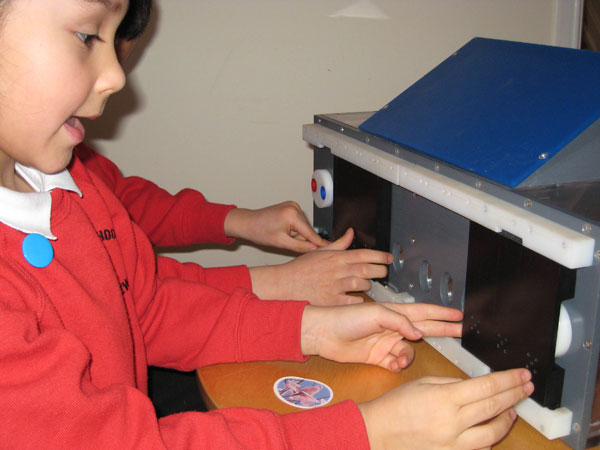Why Chimps Didn't Invent Computers

Chimpanzees can learn from each other, but their knowledge doesn’t appear to accumulate and become more complex over time — the characteristic of humans that has given rise to achievements such as computers and modern medicine.
A team of researchers wanted to know whether animals besides humans are capable of cumulative culture and what behaviors might be associated with it. To find out, they tested groups of chimpanzees, capuchin monkeys and 3- and 4-year-old children by presenting them with puzzle boxes that offered progressively better rewards at three progressively more difficult stages. The researchers watched their performance and their interaction.
The children not only were much more successful with the puzzle box, they collaborated and shared information, while the chimpanzees and the capuchins did not.
"We had one female chimp who managed to solve the puzzle box at the highest stage, but it didn't seem to spread to any other chimpanzees," Kevin Laland, a study researcher at the University of St. Andrews in Scotland, said in a podcast released by the journal Science, which is publishing the research tomorrow (March 2).
The researchers trained chimpanzees to solve the stages of the puzzle — which involved opening doors, pushing buttons and rotating a dial to get treats out of a box — and then demonstrate the techniques to other chimpanzees, but this did not seem to help them.
"In spite of having less time to access the puzzle box, we see evidence for cumulative culture in five of eight groups nursery school kids we studied, with multiple children solving the task to the highest level," Laland said.
The difference? The children demonstrated behaviors associated with cumulative culture, including teaching each other verbally, imitating others and sharing rewards. The more of these behaviors they demonstrated, the more successful the children were at solving the task.
Get the world’s most fascinating discoveries delivered straight to your inbox.
"The differences between the humans and the other two species were actually more stark than we had imagined going into this exercise," Laland said.
The capability for cumulative culture allows technology and social achievements to become more complex and diverse over time.
"Think of satellites or particle accelerators or modern medicine: These aren't things only one individual has devised. They reflect the inventions of thousands of individuals over long periods of time," Laland said in the podcast. "If you contrast animal cultures or animal social learning, they are clearly capable of learning from each other. … But seemingly they don’t exhibit this cumulative quality; there is no sort of improvement or refinement over time."
Some have claimed to have found evidence of cumulative culture in animals, but there are no clear-cut examples, according to Laland.
Laland's findings provide invaluable insight, Robert Kurzban of the University of Pennsylvania and H. Clark Barrett of the University of California, Los Angeles, write in a commentary in the same issue of Science. But they caution that other factors, such as the ability to infer causality and the mental states of others, also may have influenced performance on the puzzle box.
Kurzban and Barrett add that the behavioral differences seen between chimpanzees, which are our closest living relatives, and children don't necessarily explain the evolution of cumulative culture in humans.
You can follow LiveScience senior writer Wynne Parry on Twitter @Wynne_Parry. Follow LiveScience for the latest in science news and discoveries on Twitter @livescience and on Facebook.



